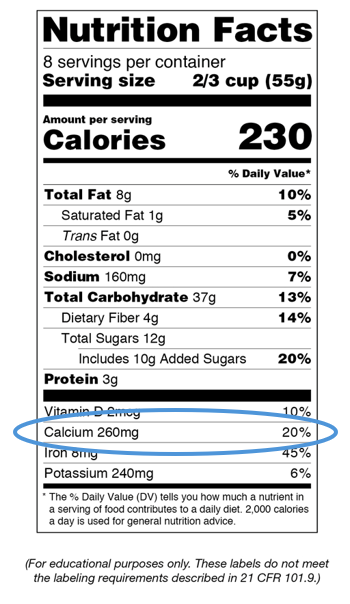By Stephanie Chang, clinical dietitian at CHOC
Why is calcium important?
Calcium is the most abundant essential mineral in the human body. It makes up the structure of bones and teeth. Calcium is also present in bodily fluids, such as blood, and is involved in muscle movement, nerve function, and blood clotting. Bones store calcium in case it is needed for body functions.
After birth, babies get enough calcium from breast milk or infant formula. Since breast milk or infant formula should be the only food for the first 6 months of life, babies meet their calcium needs. At 6 months, babies can start eating foods high in calcium, but breast milk or formula should provide most of their nutrition. At 1 year of age, cow milk or plant-based milks are usually the go-to choice to replace breast milk or formula.
But what happens if my child refuses cow milk?

There are plenty of other calcium-rich and calcium-fortified options. Calcium-rich foods have naturally occurring calcium. Examples include dairy products, legumes, and some vegetables, such as broccoli, spinach, greens, swiss chard, and kale. Calcium fortified foods have calcium added during the manufacturing process. Examples of calcium fortified foods include some cereals and breads, tofu, orange juice, and plant-based milks.
While milk is an excellent source of calcium and a popular choice among families, your child can eat enough calcium for strong bones without drinking milk. By choosing other calcium rich and calcium fortified foods, your child can easily meet the Recommended Dietary Allowance (RDA) for age.
Recommended Dietary Allowances
| Age group | Calcium (mg/day) |
|---|---|
| Birth – 6 months* | 200 |
| 6 months – 12 months* | 260 |
| 1-3 years | 700 |
| 4-8 years | 1,000 |
| 9-13 years | 1,300 |
| 14-18 years | 1,300 |
*Adequate Intake (not RDA)
Tips for choosing calcium-rich and calcium-fortified foods
When choosing calcium-fortified foods, it is very important to read the package or label. Not all cereals, tofu, orange juice, and plant-based milks are fortified.
| Tip | Details | Facts |
|---|---|---|
| Check the ingredient list | Calcium fortified foods will list one of the following: – Calcium carbonate – Calcium hydroxide – Calcium sulfate – Calcium chloride | These are chemical-sounding names, but they are ingredients food manufacturers use to add calcium. They are not harmful. |
| Check the packaging | Food manufacturers might advertise that the food has calcium. Packaging will say: – “good source of calcium” – “excellent source of calcium” | A “good” source of calcium has at least 10% of the daily value or at least 130 mg calcium. An “excellent” source has at least 20% of the daily or at least 260 mg calcium. |
| Check the nutrition facts label | Look for food that has at least 10% of the daily value for calcium. | See example below. |

So how much food does my child need to eat?
The table below provides examples of what foods to choose and how much of that food is needed to meet the RDA. Spread out these calcium food choices throughout the day. Your child should eat these with other food during a meal. Remember that children less than 1 year of age will meet their calcium needs mainly from breast milk or formula.
Food choices for one day to meet calcium needs
| Age group | Milk | No milk | No dairy |
|---|---|---|---|
| 1-3 years (Goal 700 mg calcium per day) | 2 cups (16 oz) whole milk (600 mg) ½ cup Cheerios or Rice/corn Chex (43 mg) 1/3 cup cooked broccoli (25 mg) ¼ cup yogurt (75 mg) | 1 string cheese (200 mg) ½ cup yogurt (150 mg) 3 oz strawberry yogurt drink (130 mg) 1 cup Cheerios or rice/corn Chex (87 mg) 1/3 cup cooked broccoli (25 mg) 1 slice calcium fortified bread** (185 mg) | 1 cup calcium fortified almond milk (450 mg) 1/3 cup cooked broccoli (25 mg) 1 cup Cheerios or rice/corn Chex (87 mg) 1 oz calcium set tofu (45 mg) 1 slice calcium fortified bread** (185 mg) |
| 4-8 years (Goal 1,000 mg calcium per day) | 2 cups (16 oz) low fat milk (600 mg 1 cup Cheerios or rice/corn Chex (87 mg) 2/3 cup cooked broccoli (50 mg) 1 cup yogurt (300 mg) ½ cup pinto beans (80 mg) | 1 string cheese (200 mg) 1 cup yogurt (300 mg) 1 cup Cheerios or rice/corn Chex (87 mg) 2/3 cup cooked broccoli (50 mg) 2 slices calcium fortified bread** (370 mg) | 1 cups calcium fortified almond milk (450 mg) 1 cup Cheerios or rice/corn Chex (87 mg) 1 cup pinto beans (80 mg) 2 oz calcium set tofu (90 mg) 2 slices calcium fortified bread** (370 mg) |
| 9-13 years & 14-18 years (Goal 1,300 mg calcium per day) | 2 cups (16 oz) low fat milk (600 mg 1 string cheese (200 mg) 1 ½ cup Cheerios or rice/corn Chex (130 mg) 1 cup cooked broccoli (75 mg) 1 cup yogurt (300 mg) ½ cup pinto beans (80 mg) | 2 string cheese (400 mg) 1 cup yogurt (300 mg) 1 ½ cup Cheerios or rice/corn Chex (130 mg) 1 cup cooked broccoli (75 mg) ½ cup pinto beans (80 mg) 2 slices calcium fortified bread** (370 mg) | 2 cups calcium fortified almond milk (900 mg) 1 cup cooked broccoli (75 mg) 1 ½ cup Cheerios or rice/corn Chex (130 mg) 3 oz calcium set tofu (130 mg) ½ cup pinto beans (80 mg) |
**Examples of calcium fortified bread: Nature’s Own white wheat or Sara Lee white made with whole grain
Supporting your child’s calcium and vitamin D needs — with or without dairy
Calcium is an important mineral to help children grow strong bones. By making purposeful choices, you can meet your child’s calcium needs with or without milk. You can also meet calcium needs without dairy foods.
Another important factor is vitamin D. Vitamin D helps the body absorb calcium during digestion and helps calcium build strong bones. Speak with your child’s primary care physician or dietitian about your child’s vitamin D needs. Calcium and vitamin D work together for bone health. Choosing foods that are good or excellent sources of calcium is a great way to reach your child’s calcium goals.
Get more expert health advice delivered to your inbox monthly by subscribing to the KidsHealth newsletter here.
Learn more about CHOC’s Clinical Nutrition Program
At CHOC, we specialize in providing a full continuum of pediatric nutrition services, including inpatient and outpatient services, depending on our patients’ needs.





